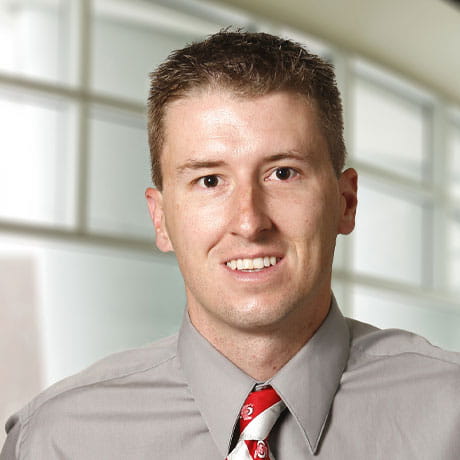 Introduce yourself
Introduce yourself
My name is Eric Adkins. I am an associate professor of Emergency Medicine and Critical Care Medicine. I’m currently vice chair for Clinical Affairs in the Department of Emergency Medicine. I am also an associate chief clinical information officer for The Ohio State University Wexner Medical Center.
I’m married to a wonderful woman, Leah Adkins, who is also a physician. She is an Ob/Gyn who really cares about providing excellent care to women.
We have three children together, ages 9, 7 and 5. Needless to say, we have crazy lives given our careers and children’s activities!
Where did you do your training?
I went to medical school at West Virginia University for four years. The first two years were in Morgantown, and then I spent the last two clinical years at the Charleston campus. I chose to do a dual residency in emergency medicine and internal medicine over five years at a hospital known as ChristianaCare in Newark, Delaware. During residency, I pursued a fellowship in pulmonary and critical care medicine. I was fortunate to match at The Ohio State University Wexner Medical Center for three years of training. It’s been a long time of education and training! When you add it all up, I spent 12 years after college before I got a 'real' job. That first real job came when I was invited to join the faculty in the Ohio State Department of Emergency Medicine and split time caring for patients between the ED and Medical ICU.What got you interested in becoming an EM physician and administrator?
When I was a young kid, I had an intense interest in helping other people. As I took an interest in medicine, I realized that emergency medicine was the opportunity I was looking for to help others. Somewhere along the way, I also took an interest in gaining as much knowledge about medicine as I could. That prompted my decision to train in both emergency medicine and internal medicine. During residency, I found myself gravitating to the sickest of the sick patients, and I knew that I wanted to be prepared to care for critically ill patients in the emergency department and in the ICU setting. I took an interest in administration as a path to not only help my patients, but also to be able to help large groups of patients as they sought out care. I also wanted to be able to improve the experience for the health care providers caring for those patients. An administrative role allows me to become deeply involved in day-to-day operations and ensure quality of care that is the best it can possibly be.Do you teach? What is your role?
I teach medical students, residents and fellows about critical illness, sepsis, patient safety, process improvement and clinical informatics/decision support at Ohio State College of Medicine.What do you enjoy doing outside of work? What are your hobbies?
I love to golf when I can. I can hit the ball reasonably straight, and I enjoy walking the course—it gives me time to think and enjoy the outdoors. Basketball is great also, but I broke my foot last year while playing a game the night before a vacation and it required surgery for a pin. It is no fun to be immobilized for extended periods of time. I am contemplating starting to play again. My wife and I love to work out together at home too, using online video workouts based around body weight exercises.Do you have any pets?
Our first 'child' was our dog. He is a 12-year-old labradoodle.What is your favorite part of your job?
I really enjoy the people I meet—patients, medical students, residents and everyone around the hospital. At the medical center, we get to see so many interesting types of illnesses, and it’s great to teach others about those illnesses, but it is also really important to get to know more about my patients and the terrific people we get to work with. I like to try to talk to everyone about something unrelated to medicine.What is one incident at the medical center that has resonated with you?
I have a lot of memories that I think about frequently. One related to working at Ohio State was the day of the attack on campus in November 2016. I was able to help lead our department that day in the response. It was great to see so many health care workers come together for one common purpose on such short notice. EMS and police (Campus and Columbus Police Department) were incredible that day. I was struck by the level of organization and coordination of the group to provide clinical care that day. As the event unfolded and eventually ended, so many people wanted to help facilitate the patient care, but they also wanted to help make sure the team members involved were coping with the stress of the event.What is one goal you would like to see come to fruition?
I have a personal goal and a departmental goal. I’m aware that the public opinion of our EDs is not always the best. I am hopeful that our EDs can continue to improve and be trusted by the people of central Ohio. I am also working toward achieving the rank of professor.
